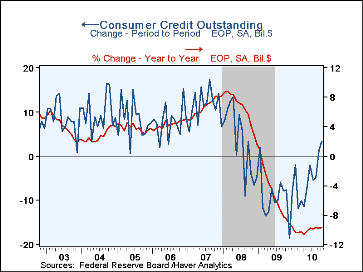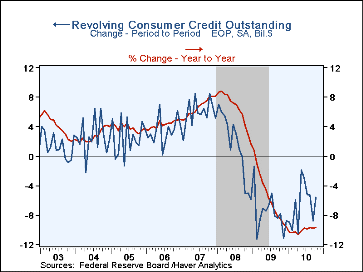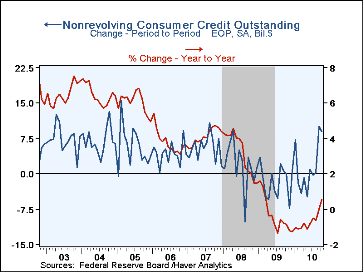 Global| Dec 08 2010
Global| Dec 08 2010U.S. Consumer Credit Usage Rebounds Again
by:Tom Moeller
|in:Economy in Brief
Summary
The consumer has started borrowing again but credit cards remain stashed away. The Federal Reserve indicated that consumer credit outstanding rose $3.3B during October after a downwardly revised $1.3B September increase. The gains [...]
 The consumer has started borrowing again but credit cards remain stashed
away. The Federal Reserve indicated that
consumer credit outstanding rose $3.3B during October after a downwardly revised
$1.3B September increase. The gains follow steady declines dating back to 2008. So far
this year, consumer credit, which does not included mortgage debt, has fallen
2.0% on the heels of last year's record 4.4% drop.
The consumer has started borrowing again but credit cards remain stashed
away. The Federal Reserve indicated that
consumer credit outstanding rose $3.3B during October after a downwardly revised
$1.3B September increase. The gains follow steady declines dating back to 2008. So far
this year, consumer credit, which does not included mortgage debt, has fallen
2.0% on the heels of last year's record 4.4% drop.
The October increase was led by a $9.0B increase in non-revolving credit outstanding. It was by far the largest increase since January and, like then, it resulted mostly from a spike in borrowing by the Federal government. It's up by half y/y. Other non-revolving credit (autos & other consumer durables), which accounts for nearly two-thirds of the total was restrained. Finance company lending fell $26.0B (-6.25 y/y) while commercial bank lending again fell m/m but was up 3.4% since last December. Credit union credit ticked up $0.8B (-6.5% y/y) while nonfinancial business borrowing slipped $0.2B (-2.4% y/y). Pools of securitized assets ticked down again m/m but were off by half from last year.
Revolving credit is what consumers still are in a hurry to shed. Outstanding balances fell $5.6B during October and by 9.6% y/y which remained near the -10.2% record set in January. (Prior to 2009, revolving credit had never been negative y/y.) Commercial bank credit fell $5.1B m/m but remained up nearly three quarters from 2009. Pools of securitized assets were unchanged from September but they're off 88.8% y/y. Finance company borrowing ticked up m/m (43.4% y/y). Credit union borrowing again was stable m/m but up a greatly reduced 3.2% y/y. Borrowing from savings institutions rose slightly but it's up by one quarter from last year.
During the last ten years, there has been a 60% correlation between the y/y change in credit outstanding and the change in personal consumption expenditures. These figures are the major input to the Fed's quarterly Flow of Funds accounts for the household sector. Credit data are available in Haver's USECON database. The Flow of Funds data are in Haver's FFUNDS database.


| Consumer Credit Outstanding (m/m Chg, SAAR) |
Oct. | Sept. | Aug. | Y/Y | 2009 | 2008 | 2007 |
|---|---|---|---|---|---|---|---|
| Total | $3.3B | $1.3B | $-5.0B | -3.1% | -4.4% | 1.5% | 5.7% |
| Revolving | -5.6 | -8.8 | -5.3 | -9.6 | -9.6 | 1.6 | 8.1 |
| Non-revolving | 9.0 | 10.1 | 0.3 | 0.5 | -1.3 | 1.5 | 4.4 |
Tom Moeller
AuthorMore in Author Profile »Prior to joining Haver Analytics in 2000, Mr. Moeller worked as the Economist at Chancellor Capital Management from 1985 to 1999. There, he developed comprehensive economic forecasts and interpreted economic data for equity and fixed income portfolio managers. Also at Chancellor, Mr. Moeller worked as an equity analyst and was responsible for researching and rating companies in the economically sensitive automobile and housing industries for investment in Chancellor’s equity portfolio. Prior to joining Chancellor, Mr. Moeller was an Economist at Citibank from 1979 to 1984. He also analyzed pricing behavior in the metals industry for the Council on Wage and Price Stability in Washington, D.C. In 1999, Mr. Moeller received the award for most accurate forecast from the Forecasters' Club of New York. From 1990 to 1992 he was President of the New York Association for Business Economists. Mr. Moeller earned an M.B.A. in Finance from Fordham University, where he graduated in 1987. He holds a Bachelor of Arts in Economics from George Washington University.






